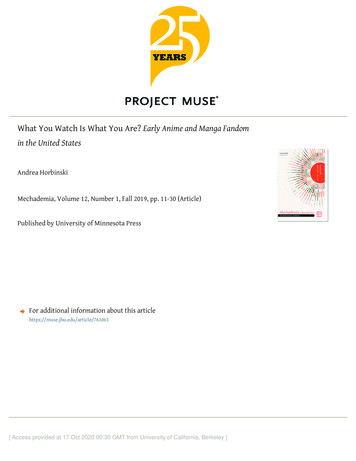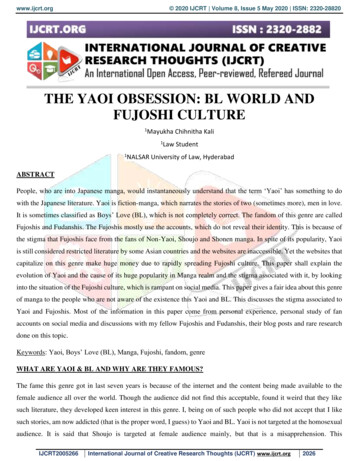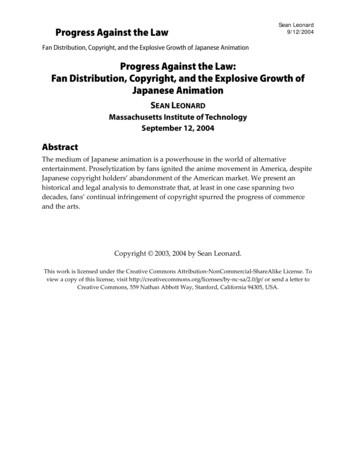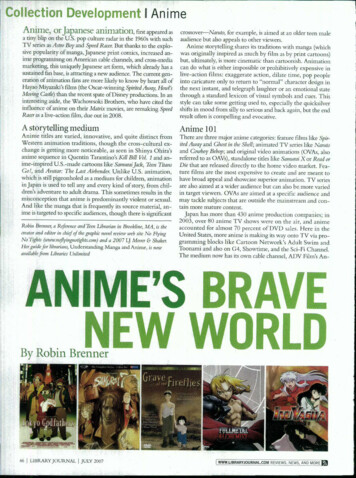
Transcription
Volume 4 Issue 3 Article ID 1900 Mar 29, 2006The Asia-Pacific Journal Japan FocusThe Auteur of AnimeMargaret TalbotThe Auteur of AnimeMargaret TalbotThe building that houses the Ghibli Museumwould be unusual anywhere, but in greaterTokyo, where architectural exuberance usuallytakes an angular, modernist form—black glasscubes, busy geometries of neon—it isparticularly so. From the outside, the museumresembles an oversized adobe house, withslightly melted edges; its exterior walls arepainted in saltwater-taffy shades of pink, green,and yellow. Inside, the museum looks like achild’s fantasy of Old Europe submitted to arigorous Arts and Crafts sensibility. The floorsare dark polished wood; stained-glass windowscast candy-colored light on whitewashed walls;a spiral stairway climbs—inside what looks likea giant Victorian birdcage—to a rooftop gardenof world grasses, over which a hammered-metalrobot soldier stands guard. In the central hall,beneath a high ceiling, a web of balconies andbridges suggests a dream vision of anineteenth-century factory. Wrought-ironrailings contain balls of colored glass, andleaded-glass lanterns are attached to the wallsby wrought-iron vines. In the entryway, a frescoon the ceiling depicts a sky of Fra Angelico blueand a smiling sun wreathed in fruits andvegetables.Ghibli MuseumSituated in a park on the outskirts of Tokyo, theGhibli Museum is dedicated to the work ofHayao Miyazaki, the most beloved director inJapan today, and—especially since his film“Spirited Away” won the Oscar for bestanimated film, in 2002—perhaps the mostadmired animation director in the world.Miyazaki’s zeal for craft and beauty has set anew standard for animated films. With fewexceptions, we seldom know the names ofdirectors of children’s films, but if you haveseen a Miyazaki film you know his name. Henot only draws characters and storyboards forthe films he directs; he also writes the rich,strange screenplays, which blend Japanesemythology with modern psychological realism.He is, in short, an auteur of children’sentertainment, perhaps the world’s first.Miyazaki designed the Ghibli himself. Themuseum was partly funded by his moviestudio—after which it is named—and is now ahugely popular, self-sustaining attraction.Though the museum is intended for children,who might be supposed not to care so much for1
4 3 0APJ JFmodels of a flying dinosaur and a red biplanehang from the ceiling; thick books about birdsand fish and the history of aviation occupy thebookshelves. As sentimental as it is, this roommakes you think with pleasure about thedreamy stage that often precedes the making ofart. Standing amid its congenial clutter, a childvisitor can easily grasp how it is, as Miyazakiwrites in the museum’s catalogue, that“imagination and premonition” and “sketchesand partial images” can become “the core of afilm.” Indeed, “Spirited Away,” the story of asullen ten-year-old girl who finds herselftransported from an abandoned theme parkinto a ravishing spirit world, was inspired inpart by Miyazaki’s own visit to a peculiaroutdoor attraction—a Tokyo museum where oldJapanese buildings, including a splendidbathhouse, had been carted from their originallocations.beauty per se, it is, in nearly every detail,beautiful. A reproduction of the cat-shaped busin Miyazaki’s “My Neighbor Totoro” (1988),which is large enough for children to climb on,has glowing golden eyes, and fur both soft andbristly, like a caterpillar’s. The museumshowcases not only the visual splendor ofMiyazaki’s films but also what inspires them:among other things, a sense of wonder aboutthe natural world; a fascination with flight; acuriosity about miniature or hidden realms.When I visited the museum this summer, itstruck me as one of the few kid-orientedattractions I know that take seriously thenotion of children as natural aesthetes—in partbecause it portrays for them a creative life thatthey might plausibly lead as adults.Miyazaki is detail-oriented to the point ofobsession—he traveled to Portugal just to lookat a painting by Hieronymus Bosch that hadlong haunted him, and sent Michiyo Yasuda,the color designer for his films, to Alsace toscout hues for his latest movie—and so, too, ishis museum. For the in-house theatre, whichshows short films that he makes especially forthe museum (including a sequel to “MyNeighbor Totoro”), he hired an acousticdesigner to create an uncommonly gentlesound system. Miyazaki wanted the opposite ofthe “tendency in recent Hollywood films,”which is “to use heavy bass to try to pull theaudience into the film.” He thinks that movietheatres can be claustrophobic, evenoverwhelming places for young children, so hewanted his theatre to have windows that let insome natural light, bench-style seats that achild can’t sink into, and films that make them“sigh in relaxation.” Miyazaki fondlyremembered the days when cigarette smoke ina theatre could draw your attention to thebeam of light stretching from the projector, sohe placed the projector in a glass booth thatprotrudes into the seating area. “I want toHayao MiyazakiOne typical exhibit, “Where a Film Begins,”depicts a room in which a young boy dreams upan idea for a movie. The room is supposed to bea study inherited from the imaginary boy’sgrandfather, and the mise en scéne captures anidealized, slightly antique coziness; a glass jarof colored pencils sits atop a wooden desk, andworn tapestry pillows rest on a library chair.The display conjures a creative young mind’shalf-glimpsed notions and sudden enthusiasms:2
4 3 0APJ JFwith modern life. He complained, “Everythingis so thin and shallow and fake.” He lamentedthe fact that children had become disconnectedfrom nature, and fulminated about thedeadening impact of video games on theimagination. Only half in jest, he said that hewas hoping for the day when “developers gobankrupt, Japan gets poorer, and wild grassestake over.” And the conversation grew onlydarker from there. A man disappointed, eveninfuriated, by the ugliness surrounding him,Miyazaki is devoted to making whatever he cancontrol—a museum, each frame of a film—asgorgeous as it can be.show children that moving images are enjoyedby having huge reels revolving, an electric lightshining on the film, and a lot of complicatedthings being done,” he explains in themuseum’s catalogue. Colleagues told him thatprojecting the films digitally would helppreserve them, but Miyazaki relished the ideathat, eventually, viewers might see “worn filmwith ‘falling-rain’ scratches on the screen.”To plan the menu for the museum café,Miyazaki hired not a professional chef but awoman who was a good home cook and hadraised four children: he wanted homemadebread; katosand, breaded pork-cutletsandwiches; and fresh vegetable soup. When heheard that children were prying open the littlewindows on a model of a house in the museum,and had broken the shutters, he was delighted,and placed pictures inside the house for kids tosee. He painted several large murals—one of acommissary, another of an old animationstudio—himself. Some of Miyazaki’s ideas couldnot be realized. He had wanted to make amountain of dirt at the Ghibli Museum—amountain with muddy, slippery stretches wherechildren “would fall and get scolded by theirmothers.” He had liked the idea, too, of a spiralstaircase that gently swayed when you walkedup it. These notions were eventually deemedunsafe or impractical, but, over all, themuseum still feels stubbornly, and joyfully,idiosyncratic.John Lasseter, the director of “Toy Story” and“A Bug’s Life,” is an ardent fan, and a friend, ofMiyazaki’s. He recently visited the GhibliMuseum with his sons. “You know how whenyou’re watching a movie, you’ll say, ‘Wow, I’venever seen that before’? With his films, thathappens in every sequence,” he said. “And hehas such a big heart; his characters and hisworlds are so rich. The museum is like having aplace to visit those worlds. It’s like whenDisneyland first opened, in the fifties—visitorsmust have felt, in a very pure way, like theyhad walked inside a Disney film.”People have been invoking Miyazaki and Disneyin the same breath for a long time, and in someways it is an apt comparison. Miyazaki films areas popular in Japan as Disney films are inAmerica. (“Spirited Away” is Japan’s highestgrossing movie ever.) Miyazaki-inspiredmerchandise-such as plush versions of theTotoro, a rotund woodland creature ofMiyazaki’s devising—is nearly as ubiquitous inJapan as Disney stuff is here. Like Walt Disney,Hayao Miyazaki started his professional careerdrawing animation cels and rose to head anindependent cartoon empire with a tentacularhold on kids’ imaginations.Despite Miyazaki’s fame—his latest film,“Howl’s Moving Castle,” grossed a record 14.5 million in its first week of release inJapan—he almost never grants formalinterviews. Yet a few days after I visited themuseum I was lucky enough to run into himduring a tour of his nearby studio, and hebegan chatting amiably. It immediately becameapparent why he was compelled to createimaginary worlds. A spry, slim man of sixtythree, with silver hair, parenthesis-shapeddimples, and thick, expressive black eyebrows,Miyazaki betrayed a profound dissatisfactionYet, in themes and style, Miyazaki’s eight filmsdo not much resemble the Disney oeuvre.Unlike Disney movies—so many of which are3
4 3 0APJ JFSatsuki, are not idealized; they are at oncegoofy, brave, and vulnerable, like a lot of kids.The sisters have just moved with their father toa new house in rural Japan. Gradually, the twogirls discover a host of strange but benignwoodland creatures: fuzzy little soot spritesthat hang out in old houses and hide when youturn on the lights; the plump, whiskeredTotoros, who live in the roots of a giantcamphor tree; and the marvelous cat bus, withits headlight eyes, caramel-colored stripes, andextra legs that function as wheels. (In a 1993televised discussion between Miyazaki and thedirector Akira Kurosawa, Kurosawa mentionedhow much he admired the sweetly surreal catbus.) There is a gentle hint of Shintoism in allthis: the father, an anthropologist, respectfullyaccepts the notion that the forest is presidedover by spirits, though he is no longer able tosee them, as his children can. Unlike theanimals in most American cartoons, thesecreaturesarenotexcessivelyanthropomorphized; they don’t speak, whichsomehow makes them seem both moreplausible and more dignified, and which givesthe girls the delightful challenge of interpretingthem. In fact, the film is focused on dignifyingthe girls’ imaginations, honoring their ability topartake in a fantasy that is both comforting andfortifying—for we gradually learn that they areseparated from their mother, who is ill and inthe hospital.based on familiar fairy tales—Miyazaki’s filmsare either original stories or his ownadaptations of fairly obscure works. Thoughthey contain set pieces of suspensefulaction—he is particularly fond of airship battlesand dramatic rescues in the sky—they have amuch quieter, less frenetic feel. In part, this isbecause they are not musicals: no brassyshowstoppers or treacly ballads interrupt thenarratives. Moreover, his films rarely havevillains of the scenery-chewing, extravagantlyblack-hearted Disney variety. Miyazakisometimes forgoes villains altogether-as in“Totoro” and the charming “Kiki’s DeliveryService” (1989), the story of an apprenticewitch—making you forget what a fixture theyare in other children’s films. His is not a blackand-white moral universe: he has sympathy forthe vain and the gluttonous and the misguided,a bemused tolerance for the poor creatures weall are. Some of his characters can bethreatening or unappealing, but also complexand capable of change—like the moody youngwizard in “Howl’s Moving Castle,” which willbe released here later this year. It might besaid that Miyazaki’s malevolent characters arecapable of redemption, except that redemptionis too Christian an idea: it’s more that theyprove capable of a kind of shape-shifting, whichallows them to reveal a different facet ofthemselves.The absence of villains also means a refreshingabsence of perfect and perfectly prettyheroines, their lives arcing toward romance.Miyazaki’s protagonists are usually girls, andthough they are likable and loyal, they tend tobe ordinary children—which makes themextraordinary in the world of children’s films.Miyazaki dwells on the latent phase ofchildhood, so that his girl characters are oftenclose friends with boys. And they can be brattyand grievously sad, as well as plucky andresourceful.A scene from My Neighbor TotoroIn “My Neighbor Totoro,” one of the loveliestchildren’s films ever made, two sisters, Mei andThe tone of the film is dreamy and playful—ithas the sun-soaked colors and languid pace of a4
4 3 0APJ JFsummer afternoon in the country—but the wayit melds such elements with a subtlepsychological treatment of the children’sanxiety over their mother makes it a radicalfilm. When four-year-old Mei learns that hermother won’t be coming home for a visit asplanned, her grief takes the form of a tantrum.She howls—her mouth a black cavern, her armsstiff. (In Disney movies, children weepdecorously or break into poignant song.)Satsuki, panicked and struggling to be themature sister, shouts at her not to be so“stupid”; Mei runs away to the hospital to findher mother. Both girls are ultimately rescuedby the cat bus, which opens up a warm, golden,womb-like interior to them—an entrancingimage of solace—and bounds across thecountryside to return them to their father.Miyazaki is a master at conveying emotions asa child would experience them: obliquely, oftenphysically, with a thread of magical thinkingthat promotes resilience.A scene from Nausicäa of the Valley of theWindMiyazaki began his animation career in thenineteen-sixties, at a time when the economicmiracle that had swiftly transformed postwarJapan into one of the strongest economies ofthe world was, almost as swiftly, obliterating itscountryside. In the nineteen-eighties, thegovernment cleaned up the worst industrialpollution, but Japan is still a country wheredevelopers (especially golf-resort planners)have free rein, where most people prefernature in tamed and miniaturized form (bonsai,Zen gardens, lavishly packaged tiny melons),and where few places are untouched bycommerce (there are vending machines on Mt.Fuji). “Spirited Away” contains a memorablescene in which a gloppy-looking creature—thespirit of a polluted river—comes to a bathhouseto be cleansed; a lot of dirty, foul-smelling laboris required. For this sequence, Miyazaki drewon his own memories of cleaning up ariver—and pulling things like bicycles out of themuck.Miyazaki’s films are also striking for theirpreoccupation with the environment, and theirnot entirely metaphorical suggestion that thenatural world is capable of remembering what’sbeen done to it. (He believes that we harbor“memories in our DNA from before we took theform of humans.”) “Nausicäa of the Valley ofthe Wind” (1984) is set in a post-apocalypticworld where humans live huddled on the edgeof a toxic forest. Its heroine finds beauty in thelush, strangely colored undergrowth and thegiant cicada-like insects that dwell there,nursing a grudge against the humans who’vepoisoned their habitat.A scene from Spirited Away5
4 3 0APJ JFwork.) Though Miyazaki incorporates somecomputer graphics in his films, he insists thatall his characters and backgrounds be drawnby hand.Miyazaki’s movies are threaded with otherpersonal obsessions, just as samurai imagerypervades Kurosawa’s work. Pigs, for example,turn up in many films. (“The behavior of pigs isvery similar to human behavior,” Miyazaki hassaid. “I really like pigs at heart, for theirstrengths as well as their weaknesses.”) A 1992film, “Porco Rosso,” tells the story of a pig thatflies—he’s a pilot who works the skies over theAdriatic before the Second World War. In onetender scene, the pig recalls the air battle inwhich his fellow flying aces just keptascending—floating ever upward into a coldempyrean death—while he, a more earthboundcreature, could not face such self-sacrifice.Next month, Disney, the American distributorof Miyazaki’s films, will release a video versionof “Porco,” whose title charter will be voiced byMichael Keaton. It will also make available anEnglish version of “Nausicäa, with voices byUma Thurman and Patrick Stewart. With thesetwo releases, the entirety of Miyazaki’seccentric output will be available in goodEnglish versions for the first time.Toshio Suzuki, a wry, articulate man with closecropped silver hair and an elfin grin, isMiyazaki’s producer and longtime collaborator.“When silents moved to talkies, Chaplin heldout the longest,” he told me. “When black-andwhite went to color, Kurosawa held out thelongest. Miyazaki feels he should be the one tohold out the longest when it comes to computeranimation.” Miyazaki lavishes particularattention on his backgrounds, which are full ofpainterly flourishes. I’d never really noticed thecolors in an animated film until I noticed his.Skies and seas are saturated in strangelyemotional blues; wet halos surround the redlantern and absinthe-green neon signs in“Spirited Away”; in “Kiki’s Delivery Service,”the young witch’s dress isn’t quite black—it’sthe smudged purple of the darkest plums.A scene from Kiki's Delivery ServiceEven Miyazaki’s most outlandishly imaginedcreatures have an unnerving realism. Theeerie, poignant No Face in “Spirited Away” is acreature who wears a mask, whimpers softly,and eats everything in sight, greedily eager forcommunion with others; he glides along like aninky rain cloud, and expands just as ominously.In the same film, a flock of white paper birdsflash through the sky: they are like origami,only sharp-edged, and capable of drawingblood.A scene from Porco RossoJohn Lasseter told me that when the animatorsat Pixar get stuck on a project they go into ascreening room and watch a Miyazaki film. Theirony of this admiration is that Miyazaki is anold-fashioned artist who has rejected thecomputerized path that many animationstudios, including Pixar, have taken. (Last year,Disney closed down its hand-drawn-animationunit, in Florida, in favor of digitally rendered6
4 3 0APJ JFshort?”Chihiro encounters No Face in Spirited Away.Miyazaki’s starting point for a film, Suzuki said,is often a small visual detail. Five years ago,when Miyazaki read a Japanese translation ofthe book “Howl’s Moving Castle,” by DianaWynne Jones, a British author, he wasimmediately taken with the idea of a castle thatambulates around the countryside. “The booknever explains how it moves, and that triggeredhis imagination,” Suzuki recalled. “He wantedto solve that problem. The first thing he did onthe film was to start to design the castle. Howwould it move? It must have legs, and he wasobsessed with settling this question. Wouldthey be Japanese warrior legs? Human-typefeet? One day, he suddenly said, ‘Let’s go withchicken feet!’ That was, for him, thebreakthrough.” Suzuki thinks of Miyazaki’sapproach as uniquely Japanese: “In traditionalJapanese architecture, you start with oneroom—maybe the alcove, where you hang somepictures. You spend a lot of time trying to pickthe right shelves, the right little pillar, whatkind of handles the drawers will have. Onlywhen you finish that room do you worry aboutthe next. In the West, you start from thegeneral and go to the specific. A Hitchcockmovie might start off with a panorama of thecity, and then the camera closes in on a street,and a house, and then the stairway inside. Ifyou’re a Japanese filmmaker, you might startwith the railing on the stairway. When Miyazakimakes a film, he is thinking, like with this newone, O.K., first off, here are two very importantpoints to settle: Does Sophie, the little girl inthe movie, have braids or not? Are they long orFrom Howl's Moving CastleBut it wouldn’t be quite right to describeMiyazaki’s approach as wholly Japanese. Aswith fantasy writers in the British tradition,from C.S. Lewis to J.K. Rowling, Miyazakimakes the details of the worlds he createsconcrete and coherent, so that we might bettersuspend our disbelief for the big leaps offantasy. This devotion to realism, Suzukiacknowledges, “is rare in Japanese animation,”which tends to revel in the freedom fromearthly laws that the medium allows. Miyazakican be steely in pursuit of this goal. In aJapanese television documentary about“Spirited Away,” he is shown at a meeting withhis young staff, explaining how they are todraw certain images based on his storyboards.“The dragon is supposed to fall from down theair vent, but, being a dragon, it doesn’t land onthe ground,” Miyazaki says. “It attaches itself7
4 3 0APJ JFto the wall, like a gecko. And then—ow!—itfalls—thud!—it should fall like a serpent. Haveyou ever seen a snake fall out of a tree?” Heexplains that it “doesn’t slither, but holds itsposition.” He looks around at the animators,most of whom appear to be in their twentiesand early thirties. They are taking notes,looking grave: nobody has seen a snake fall outof a tree.“Any of you ever had a dog?” Miyazaki asks.Miyazaki goes on to describe how thedragon—a protean creature named Haku, whosometimes takes this form—struggles when heis pinned down. “This will be tricky,” Miyazakisays, smiling. “If you want to get an idea, go toan eel restaurant and see how an eel is gutted.”The director wriggles around in his seat,imitating the action of a recalcitrant eel. “Haveyou ever seen an eel resisting?” Miyazaki asks.It seems almost inevitable that the world’sgreatest animator should be Japanese. Over thepast decade or so, Japan has become, outsidethe United States, the most successful exporterof children’s pop culture. With television showslike “Poké-mon” and “Yu-Gi-Oh!,” which havelarge casts of creatures accompanied by theirown stats and trading cards, the Japanesefigured out how to tap into children’s mania forcollecting and classifying. With shows like“Hamtaro” (Little Hamsters, Big Adventures”)and “Sailor Moon” (in which giggly, shopaholicschoolgirls turn into saviors of the world), theygot the idea that overmuscled superheroes, asalluring as they are, can seem out of reach,whereas smaller creatures that aresimultaneously cute and powerful are easy toidentify with. With Hello Kitty—the blank, bigheaded cartoon cat—they proved thatinnocence was an aesthetic that could bepushed to extremes. Sanrio, the company thatmanufactures tens of thousands of Hello Kittyproducts—from pink vinyl coin purses topackets of “sweet squid chunks” bearing herwide-eyed likeness—is a billion-dollar business.“I had a cat,” somebody volunteers.“This is pathetic,” Miyazaki says. Thedocumentary shows the chastened staff makinga field trip that night to a veterinary hospital,videotaping a golden retriever’s gums andteeth, and then returning to the studio to studythe video.Chihiro on Haku the dragon in Spirited Away“No, actually,” admits a young man withhipster glasses, an orange sweatshirt, and anindoor pallor.One reason the Japanese are so good at thiskind of thing is that many adults in Japan arecuriously attuned to cuteness. Even in acosmopolitan city like Tokyo, kawaii—or “cute”culture—is everywhere: road signs are adornedwith adorable raccoons and bunnies; stuffedanimals sit on salarymen’s desks; Hello Kittycharms are offered for sale at Shinto shrines. Itis also a culture where anime (cartoons) andmanga (comic books) are both widelyconsumed and, in some cases, highly regardedMiyazaki groans. “Japanese culture is doomed!”He says. When he describes a scene in whichhis heroine, Chihiro, forces open the dragon’smouth to give it medicine, he says theanimators should be thinking, as they draw, ofwhat it’s like to feed a dog a pill, when you tipits head to the side, and “the dog clenches itsteeth and its gums stick out.” There is morenote-taking, but no sign that this might be afamiliar experience.8
4 3 0APJ JFused to be for young people. Now people intheir forties are the ones who are supportingit.” When he watches movies at all these days,he said, he prefers documentaries, especially“the simple ones that just try to show otherpeople and other civilizations. They have theirown distortions, but, still, I like them.” He is aleftist who thinks that too many people aremaking money off children, who frets over thespectre of virtual reality “eating into ouremotional life,” and who wishes that we coulddrastically reduce the number of video gamesand DVDs available for sale. He worries that heis contributing to the problem by making animehimself, and isn’t keen on promoting his ownfilms, which is one reason that he resists givinginterviews.as art and literature. No one knows exactly whycomic books are so popular in Japan; onetheory is that they grew out of woodblockprints and seemed naturally connected to abroader artistic tradition that produced some ofits best work in ephemeral, everyday objectslike fans and screens. In any case, manga makeup nearly half of the book sales in Japan, andyou see people of all ages reading them on thesubway. Animated programs, of which ninety orso air on Japanese TV every week, have longbeen shown in prime time, on the assumptionthat families will watch them together. Andwhile much anime and manga is intended foradults—violent sci-fi and pornography, as wellas contemplative family dramas—the marketfor children remains the largest. Althoughmuch of Japan’s kid-oriented anime has beenexported to the U.S., a great deal more—suchas “Anpanman,” a hugely popular series abouta bean-paste-stuffed bread roll—has not. (A fanWeb site notes, “To a non-Japanese person, theconcept of a living bread superman who fightsgiant germs and feeds the hungry with piecesof his head may seem bizarre.”)Several people who know Miyazaki told me thatmothers frequently approach him to tell himthat their child watches “Totoro” or “Kiki”every day, and he always acts horrified. “Don’tdo that!” he will say. “Let them see it once ayear, at most!” In an essay he wrote in 1987, hewas already concerned: “No matter how wemay think of ourselves as conscientious, it istrue that images such as anime stimulate onlythe visual and auditory sensations of children,and deprive them of the world they go out tofind, touch, and taste.” And yet he would not bequite the figure he is—recognized by childrenon the street, in a position to make just aboutany movie he wants—in a country that did nothonor animation and fetishize childhood quiteso much.Hayao Miyazaki was born in Tokyo in 1941. Hisfather helped run a family-owned factory thatmade parts for military airplanes. His mother,like the mother in “Totoro,” was sickly andoften bedridden, but she was also smart andstrong-willed. “My grandfather was affluent,and he knew how to live,” Goro Miyazaki, oneof the director’s two sons, recalled. I spokewith him last summer at the Ghibli Museum,where he is the curator. “He liked to havefun—he liked to go to restaurants and movies.Hello KittyMiyazaki distances himself from all thiscommercialism. He doesn’t care for a lot ofcontemporary Japanese animation. “Animatorsare getting too old,” he told me. “Animation9
4 3 0APJ JFMy grandmother was very intelligent and notparticularly interested in going out. She hadher own mind and she didn’t like to spendmoney. She exerted a huge influence onMiyazaki. When he was young, he had all thesequestions—big ideas—and it was his mother hecould talk to about them. He was on of fourboys, and he was the closest to her.”him. “My soul was moved and I stumbled backhome in the snow that had just started.Comparing my pitiful situation to thecharacters’ earnestness, I was ashamed ofmyself, and cried all night.” At the time, he hadbeen trying to write a sophisticated, absurdistmanga, but he realized, somewhat to hisembarrassment, that he was more interested increating something sincere.His friend Suzuki was more direct. “He was amama’s boy,” he said. Suzuki thinks the factthat there is always an old woman in Miyazaki’sfilms, and that she is often a trenchantcharacter, is a tribute to the director’s mother.“When he was small, and his mother was ill, thefour brothers took turns helping out withchores. But he loved her the best of all ofthem.” (Like the tough grannies in his movies,Miyazaki’s mother surprised everyone by livinginto old age.)Neither of Miyazaki’s parents was artistic. “Mygrandfather liked buying paintings, and heliked to show them off to guests,” GoroMiyazaki said. “But I don’t know that he hadany particular artistic understanding. It’s amystery where Miyazaki’s talent came from. Hehad a kind of a complex toward his brothers,and that gave him a strong motivation tosucceed at animation. His brothers went intobusiness; they were more influenced by theirfather. But success wasn’t easy for him. Hewasn’t dexterous, and he really had to work toachieve what he has.”Poster for Legend of White SnakesAt Gakushuin University, in Tokyo, Miyazakistudied economics and political science. But healso joined a children’s-literature group, wheremembers read and discussed fantasy fiction. Asa senior in high school, Miyazaki had sneakedout to see the first Japanese animated filmmade in color, “The Legend of the WhiteSnake,” when he was supposed to be studyingfor his entrance exams. The film had a bigimpact on him, he wrote years later, becausewhile he could see that it was “cheapmelodrama,” its naked emotionalism touchedIn 1963, Miyazaki went to work as a rookieanimator at Toei Animation, in Tokyo, whichprimarily made cartoons for television. Thecompany’s animation had a particularstyle—the style we associate with anime ingeneral, though not so much withMiyazaki—and it derived mainly from economicnecessity. Japanese studios were not thewealthy behemoths that Disney and WarnerBros. were, and they saved money by havinganimators draw fewer cels. The result was10
4 3 0APJ JFjerkier, with more
Japan as Disney stuff is here. Like Walt Disney, Hayao Miyazaki started his professional career drawing animation cels and rose to head an independent cartoon empire with a tentacular hold on kids' imaginations. Yet, in themes and style, Miyazaki's eight films do not much resemble the Disney oeuvre. Unlike Disney movies—so many of which are










